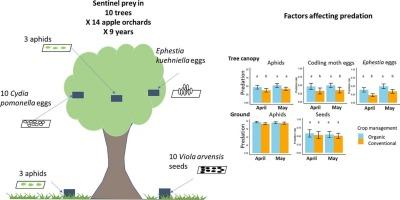Sentinel prey settings differ in their ability to distinguish organic from conventional apple orchards and in their sensitivity to weather conditions during field exposure
IF 3.4
2区 农林科学
Q2 BIOTECHNOLOGY & APPLIED MICROBIOLOGY
引用次数: 0
Abstract
Determining factors that affect pest predation by natural enemies is essential for designing cropping systems that promote conservation biological control. Predation of sentinel prey has become an increasingly popular measure of predator activity for comparing fields with differing characteristics of interest. However, many different sentinel prey exist, and such studies rarely examine how the specific prey used influences their conclusions, especially in perennial crops. We compared the ability of four sentinel prey, placed either in the tree canopy (eggs of two Lepidoptera, Cydia pomonella and Ephestia kuehniella, and aphids, Acyrthosiphon pisum) or on the ground (aphids, A. pisum, and seeds of Viola arvensis), to differentiate between organic and conventional apple orchards. Furthermore, we assessed whether their predation depended on weather conditions during field exposure. We monitored predation of these sentinel prey during two field sessions (April and May) over nine years in 14 apple orchards. Predation of aphids exposed for 24 h on the ground was always high. Predation of all other prey, except seeds, was higher in organic than in conventional orchards, particularly during the April field session. Additionally, the predation of seeds, and to a lesser extent of aphids, was influenced by weather conditions during exposure. Ephestia eggs emerged as a suitable choice for comparing predation by generalist predators among orchards, as they were easy to handle and their predation rates were positively correlated with those of aphids exposed in the tree canopy. Codling moth eggs displayed a somewhat different predation pattern and could be a valuable complement.

哨兵猎物环境的不同之处在于它们区分有机苹果园和传统苹果园的能力,以及它们在田间暴露期间对天气条件的敏感性
确定影响天敌捕食的因素对于设计促进保护性生物防治的种植制度至关重要。哨兵猎物的捕食已成为一种日益流行的衡量捕食者活动的方法,用于比较具有不同兴趣特征的领域。然而,存在许多不同的哨兵猎物,这些研究很少检查特定猎物的使用如何影响他们的结论,特别是在多年生作物中。我们比较了放置在树冠上的四种哨兵猎物(两种鳞翅目植物Cydia pomonella和Ephestia kuehniella的卵以及蚜虫Acyrthosiphon pisum)或放置在地面上的四种哨兵猎物(蚜虫A. pisum和Viola arvensis的种子)区分有机苹果园和常规苹果园的能力。此外,我们评估了它们的捕食是否取决于野外暴露期间的天气条件。在9年的时间里,我们对14个苹果园进行了4月和5月的两次野外监测。在地面暴露24 h的蚜虫的捕食率始终较高。除种子外,有机果园的所有其他猎物的捕食率都高于常规果园,特别是在4月的田间会议期间。此外,种子的捕食受到暴露期间天气条件的影响,蚜虫的捕食也受到较小程度的影响。以艾弗提虫卵为比较果园间多面手捕食者捕食的适宜选择,因为艾弗提虫卵易于处理,且其捕食率与暴露在树冠上的蚜虫的捕食率呈正相关。孵化蛾卵显示出不同的捕食模式,可能是一种有价值的补充。
本文章由计算机程序翻译,如有差异,请以英文原文为准。
求助全文
约1分钟内获得全文
求助全文
来源期刊

Biological Control
生物-昆虫学
CiteScore
7.40
自引率
7.10%
发文量
220
审稿时长
63 days
期刊介绍:
Biological control is an environmentally sound and effective means of reducing or mitigating pests and pest effects through the use of natural enemies. The aim of Biological Control is to promote this science and technology through publication of original research articles and reviews of research and theory. The journal devotes a section to reports on biotechnologies dealing with the elucidation and use of genes or gene products for the enhancement of biological control agents.
The journal encompasses biological control of viral, microbial, nematode, insect, mite, weed, and vertebrate pests in agriculture, aquatic, forest, natural resource, stored product, and urban environments. Biological control of arthropod pests of human and domestic animals is also included. Ecological, molecular, and biotechnological approaches to the understanding of biological control are welcome.
 求助内容:
求助内容: 应助结果提醒方式:
应助结果提醒方式:


